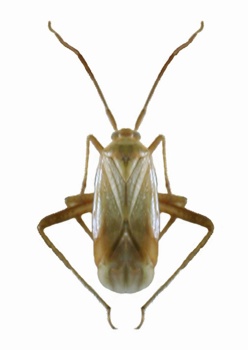Pests
Adelphocoris lineolatus Goeze - Lucerne Plantbug
Systematic position.
Class Insecta, order Hemiptera, family Miridae, genus Adelphocoris.Biological group.
This is an oligophagous pest of legumes.Morphology and biology.
Adult bugs are grayish-green or grayish-yellow (body length 7.6-9.5 mm). Head is wider than long, antenna hardly shorter than body. Pronotum is monochrome or has 2-4 dark spots; scutellum with two median brown strokes. Egg elongated, slightly bent, with smoothly cut anterior apex and rounded hind apex, white, later yellowish, without reticulation on chorion. Larvae are yellowish-green, with reddish or reddish-brown apex of abdomen (younger larvae) or entirely grass-green. Body covered with sparse black hairs. Antennae are grayish-brown with carmine-red fourth segment (younger larvae) or yellowish-green with darkened apical segments. Eggs over-winter. Females lay 80-120 eggs on the average, sometimes up to 300. Bugs place eggs into young stems and branches of lucerne and other plants, not always host ones (for example, bindweed). Eggs are placed in a batch in an irregular longitudinal row, almost side by side, or with intervals that are bigger than diameter of egg cap. Under optimum conditions (at average daily air temperature 19-30°C and humidity 60-70%), the eggs develop in 8-12 days on the average. Some of the eggs will diapause until the next spring. Duration of larva stage of 1st generation is 20-30 days. Younger larvae keep on the lower and middle parts of plants on leaves, branches, and even on ground. Development of larvae of 2nd generation lasts 20-25 days.Distribution.
This is a palearctic species. It lives in Western Europe, Northern Africa, Middle East, Afghanistan, Pakistan, Mongolia, China, Japan; adventive in Northern America. In the former USSR it is distributed in the European part southward of Petrozavodsk, Kotlas, and Ukhta, in the south of Siberia and the Far East, in Kazakhstan and Central Asia.Ecology.
The Lucerne Plantbug has 1-1.5 generations in regions located north of Ukraine and in Siberia, 2 (rarely 3) generations in Ukraine, 3-4 generations in Crimea, the Caucasus and, Central Asia. Humid vegetation residues at air temperature 12-14°C and higher favor fast development of embryos in spring and rapid hatching of larvae. Hot, dry, and windy weather restrains development of embryos. Long-drawn rainless weather causes death of a significant part of embryos. Optimum temperature for the embryo development is 18-24°C. Spring larvae appear in mid-April in Central Asia and Transcaucasia, in the beginning of May in Forest-steppe of Ukraine, at the end of May or in the beginning of June in Nizhnii Novgorod Region, when host plants are juicy and soft. Larvae of 1st instar are weakly harmful. Appearance of larvae of 2nd-3rd instars usually coincides with the beginning of flower bud formation. The larvae rise toward young inflorescences and stem tops, causing the greatest harm to seed crops. Similar conditions slow down development of larvae of the 2nd generation. Alate bugs appear in the beginning of May in Central Asia, in the beginning of June in forest-steppe zone of Ukraine, flying until July. Bugs start oviposition 5-7 days after the first flight. Formation of eggs stops at temperature 18°C and lower, and fertility of females is reduced. In the zone of 2 generations of the bug (i.e., forest-steppe and steppe zones) the hatching of larvae of summer generation occurs mainly in middle or last third of July. Bugs appear in conditions of forest-steppe zone in the 2nd half of July, and they die off from the end of August. Development of pre-imaginal stages of the 2nd generation is even more long-drawn, than that of the 1st generation, but a part of population sometimes produces a 3rd generation of the pest. Adult individuals and larvae are observed in the Forest-steppe of Ukraine until mid-September or first half of October.Economic significance.
The pest causes damage to lucerne, sainfoin, less often melilot, clover, lupine and other leguminous grasses, sporadically cotton, peanut, chick-pea, lentil, soya, string bean and sunflower. Bugs of the 2nd generation sometimes cause damage to seed-growing plants of sugar beet. Larvae can develop on many wild-growing legumes along with some composites, crucifers, and goosefoots. Larvae and imagoes of the pest destroy sprouts or damage their points of growth, depress young shoots and pedicles, destroy leaf and flower buds, damage young, not yet hardened beans and seeds.Control measures.
Agronomical measures include spatial isolation of crops of perennial leguminous grasses at a distance of at least 0.5-1 km, optimum 1-1.5 km; use of wide-row sowings (45-60 cm) for cultivation of seed lucerne; haying of grasses in dry and hot weather prior to the appearance of alate insects; correct choice of terms of harvesting for hay or seeds; destruction of wintering eggs by low cutting with subsequent harrowing and burning of residues. Chemical measures include the application of insecticides in the beginning of budding of leguminous cultures against larvae of middle instars.Reference citations:
Puchkov V.G. 1966. Main Miridae - agricultural pests. Kiev: Naukova dumka. 71 p. (In Russian)Puchkov V.G. 1972. Hemiptera (Heteroptera). In: Kryzhanovskii O.L., Dantsig E.M., eds. Insects and mites - pests of agricultural plants. V. 1. Primitive insects. Leningrad: Nauka. 222-262 p. (In Russian)
Puchkov V.G. 1973. Miridae. In: Vasil.ev V.P., ed. Pests of agricultural crops and forest plantations. V. 1. Kiev: Urozhai. 324-337 p. (In Russian)


